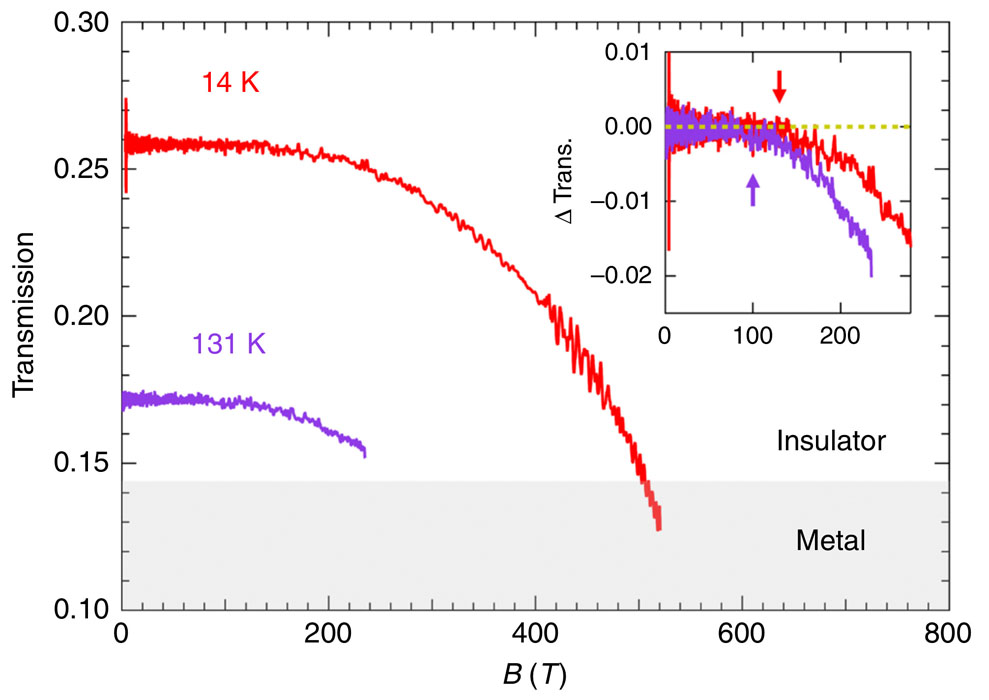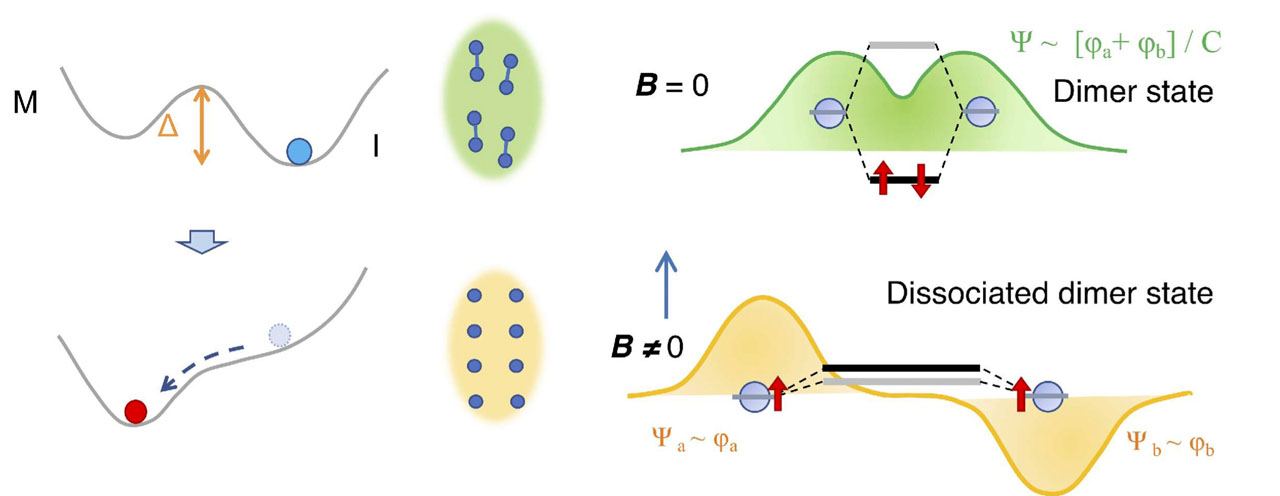Magnetic-Field-Induced Insulator-Metal Transition in a Strongly Correlated Insulator V1-xWxO2 at 500 T
Y. H. Matsuda and Takeyama Groups
The magnetic ground state of most of strongly correlated insulators is antiferromagnetic ordered state. Roles of electron spins in realizing the insulating nature in correlated systems is well understood in the single-band Hubbard model; the magnetic energy determined by the exchange interaction J is much smaller than the Coulomb energy U, and thus the electrical insulating nature is essentially insensitive to the magnetic state. In some of actual materials, however, spin degree of freedom couples to crystal lattice through the orbital degree of freedom and results in nontrivial electronic states. Actually, in some of the strongly correlated insulators, the ground state exhibits spin-singlet state instead of the antiferromagnetic state. One of the most studied correlated insulators with the singlet ground state is VO2 that undergoes a very sharp metal-insulator transition at 340 K. It has been debated for more than 60 years whether the electron correlation or the structural instability is more essential driving force behind the transition.
In the present work, we have demonstrated that a tungsten (W)-doped VO2 undergoes insulator-metal (IM) transition by applying a ultrahigh magnetic field of 500 T. The field is produced by the electromagnetic flux compression 1000-T generator at the ISSP [1]. Figure 1 shows the magneto-transmission of a V0.94W0.06O2 thin film at 1.977 μm [2]. A reduction of the transmission with magnetic field when the field is greater than 100 T is a direct evidence of the field induced metallization. One of the most probable explanation for the field-induced IM transition is that the singlet-dimer state is suppressed by such a ultrahigh magnetic field, and which results in breaking of structural V-V dimers as well. The molecular orbital occupied by two electrons with different spin directions is collapsed by forced alignment of the two spins by the strong magnetic field of 500 T. The discovered spin-controlled IM transition suggests that the principal driving force to the insulating state at a low temperature is structural instability (formation of dimers) rather than the electron correlation.

Fig. 1. Magnetic-field dependence of the optical transmission at 14 and 131 K. The transmission is plotted before the breaking point of the destructive measurement. The shaded area indicates transmission lower than that in the high-temperature metallic phase at 291 K. Inset: transmission change ∆Trans. as a function of the magnetic field. The dashed yellow line corresponds to ∆Trans.= 0. The red and purple arrow indicate the field positions (B*) where ∆Trans. deviates from zero.
From another view point, the observed collapse of the V-V dimer is a similar phenomenon with the so-called the chemical catastrophe where a chemical bond is destroyed by the Zeeman effect of a super-strong magnetic field greater than 106 T in the cosmic space [3]. An energy to collapse the molecular orbital of the V-V dimer is scaled down by 3-4 orders of magnitude in a solid compared to a normal molecule, which enable us to observe the chemical catastrophe in a solid. Figure 2 is a schematic of the field-induced IM transition of W-doped VO2; the V-V dimers are dissociated by forced alignment of spins in a 500-T-field [2].

Fig. 2. Schematic of the magnetic-field-induced insulator-metal (IM) transition. The left side shows that the potential barrier ∆ is lowered by the Zeeman energy. The middle part schematically shows the collapse of the V–V dimers. The right part shows that applying a magnetic field induces the dissociation of the dimer owing to the destabilization of formation of the bonding state Ψ of the molecular orbital, where φa and φb are the wave functions of the independent vanadium ions.
References
- [1] D. Nakamura, Akihiko Ikeda, H. Sawabe, Y. H. Matsuda, and S. Takeyama, Rev. Sci. Instrum. 89, 095106 (2018).
- [2] Y. H. Matsuda, D. Nakamura, A. Ikeda, S. Takeyama, Y. Suga, H. Nakahara, and Y. Muraoka, Nat. Commun. 11 3591 (2020).
- [3] M. Date, Australian Journal of Physics 48, 187 (1995).
